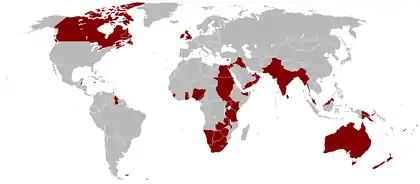Military production during World War II
Military production during World War II was the arms, ammunition, personnel and financing which were produced or mobilized by the belligerents of the war from the occupation of Austria in early 1938 to the surrender and occupation of Japan in late 1945.
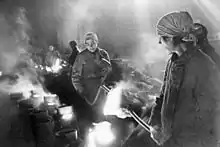
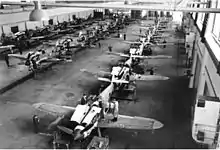

The mobilization of funds, people, natural resources and material for the production and supply of military equipment and military forces during World War II was a critical component of the war effort. During the conflict, the Allies outpaced the Axis powers in most production categories. Access to the funding and industrial resources necessary to sustain the war effort was linked to their respective economic and political alliances. As formerly neutral powers, such as the United States, joined the escalating conflict, territory changed hands, combatants were defeated, and the balance of power shifted in favor of the Allies -- as did the means to sustain the military production required to win the war.
Historical context
During the 1930s, political forces in Germany increased their financial investment in the military to develop the armed forces required to support near- and long-term political and territorial goals. Germany's economic, scientific, research and industrial capabilities were one of the most technically advanced in the world at the time and supported a rapidly growing, innovative military. However, access to (and control of) the resources and production capacity required to entertain long-term goals (such as European control, German territorial expansion and the destruction of the USSR) were limited. Political demands necessitated the expansion of Germany's control of natural and human resources, industrial capacity and farmland beyond its borders. Germany's military production was tied to resources outside its area of control, a dynamic not found amongst the Allies.
In 1938 Britain was a global superpower, with political and economic control of a quarter of the world's population, industry and resources, in addition to its close allies in the independent Dominion nations (such as Canada and South Africa). From 1938 to mid-1942, the British coordinated the Allied effort in all global theatres. They fought the German, Italian, Japanese and Vichy armies, air forces and navies across Europe, Africa, Asia, the Middle East, India, the Mediterranean and in the Atlantic, Indian, Pacific and Arctic Oceans. British forces destroyed Italian armies in North and East Africa and occupied overseas colonies of occupied European nations. Following engagements with Axis forces, British Empire troops occupied Libya, Italian Somaliland, Eritrea, Ethiopia, Iran and Iraq. The Empire funded and delivered needed supplies by Arctic convoys to the USSR, and supported Free French forces to recapture French Equatorial Africa. Britain also established governments in exile in London to rally support in occupied Europe for the Allied effort. The British held back or slowed the Axis powers for three years while mobilising their globally integrated economy and industrial infrastructure to build what became, by 1942, the most extensive military apparatus of the war. This allowed their later allies (such as the United States) to mobilise their economies and develop the military forces required to play a role in the war effort, and for the British to go on the offensive in its theatres of operation.
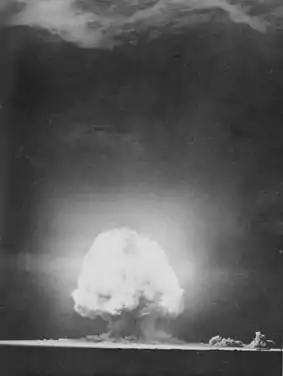
The entry of the United States into the war in late 1941 injected financial, human and industrial resources into Allied operations. The US produced more than its own military forces required and armed itself and its allies for the most industrialized war in history.[1] At the beginning of the war, the British and French placed large orders for aircraft with American manufacturers and the US Congress approved plans to increase its air forces by 3,000 planes. In May 1940, Franklin D. Roosevelt called for the production of 185,000 aeroplanes,120,000 tanks, 55,000 anti-aircraft guns and 18 million tons of merchant shipping in two years. Adolf Hitler was told by his advisors that this was American propaganda; in 1939, annual aircraft production for the US military was less than 3,000 planes. By the end of the war US factories had produced 300,000 planes,[2][3] and by 1944 had produced two-thirds of the Allied military equipment used in the war — bringing military forces into play in North and South America, the Caribbean, the Atlantic, Western Europe and the Pacific.
The U.S. produced vast quantities of military equipment into late 1945, including nuclear weapons, and became the strongest, most technologically advanced military forces in the world. In addition to out-producing the Axis, the Allies produced technological innovations; through the Tizard Mission, British contributions included radar (instrumental in winning the Battle of Britain), sonar (improving their ability to sink U-boats), and the proximity fuze; the Americans led the Manhattan Project (which eliminated the need to invade Japan). The proximity fuze, for example, was five times as effective as contact or timed fuzes and was devastating in naval use against Japanese aircraft and so effective against German ground troops that General George S. Patton said it "won the Battle of the Bulge for us."[4]
The human and social costs of the war on the population of the USSR were immense, with combat deaths alone in the millions. Recognising the importance of their population and industrial production to the war effort, the USSR evacuated the majority of its European territory—moving 2,500 factories, 17 million people and great quantities of resources to the east.[5] Out of German reach, the USSR produced equipment and forces critical to the Axis defeat in Europe. Over one million women served in the Soviet armed forces.
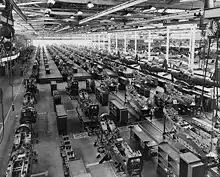
The statistics below illustrate the extent to which the Allies outproduced the Axis. Production of machine tools tripled, and thousands of ships were built in shipyards which did not exist before the war.[6] According to William S. Knudsen, "We won because we smothered the enemy in an avalanche of production, the like of which he had never seen, nor dreamed possible."[7]
Access to resources and large, controlled international labour pools and the ability to build arms in relative peace were critical to the eventual victory of the Allies. Donald Douglas (founder of the Douglas Aircraft Company) declared, "Here's proof that free men can out-produce slaves."[8]
Production summaries 1939–1945
Personnel
| Service | Allies | Axis |
|---|---|---|
| Combat | 25,000 | |
| Auxiliary force | 15,000 | |
| Merchant Marine | 50,000 | |
| Irregulars | 90,000 | |
| Total | 80,000,000 | 30,000,000 |
Major weapons groups
| System | Allies | Axis |
|---|---|---|
| Tanks, self-propelled artillery, vehicles | 4,358,649 | 670,288 |
| Artillery, mortars, guns | 6,792,696 | 1,363,491 |
| Aircraft | 637,248 | 229,331 |
| Missiles | (only for test) | 45,458 |
| Ships | 54,931 | 1,670 |
Economy
In thousands of international dollars, at 2014 prices.
| Service | Allies | Axis |
|---|---|---|
| GDP | 97,707,908,723.20 | 10,268,201,776.37 |
| Expenditure |
Vital commerce and raw materials
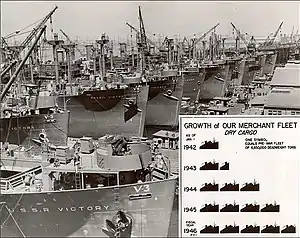
| Category | Allies | Axis |
|---|---|---|
| Cargo ships | 47,118 | 12,762 |
| Merchant shipping | 46,817,172 | 5,621,967 |
| Coal | 4,581,400,000 | 2,629,900,000 |
| Crude oil | 1,043,000,000 | 66,000,000 |
| Steel | 733,006,633 | x |
| Aluminium | 5,104,697 | 1,199,150 |
| Asbestos | 3,934,043 | x |
- Cargo and resources in metric tonnes
Production overview: service, power and type
Land forces
| Power | Tanks & SPGs | Armoured vehicles | Other vehicles | Artillery | Mortars | Machine guns | Personnel |
|---|---|---|---|---|---|---|---|
| British Empire | 47,862 | 47,420 | 1,475,521 | 226,113 | 239,540 | 1,090,410 | 11,192,533 |
| USA and territories | 108,410 | 2,382,311 | 257,390 | 105,055 | 2,679,840 | 10,000,000 | |
| USSR | 119,769 | 197,100 | 516,648 | 200,300 | 1,477,400 | 34,401,807 | |
| Other | |||||||
| Allies | 270,041 | 47,420 | 4,054,932 | 1,000,151 | 544,895 | 5,247,650 | |
| Germany and territories | 67,429 | 49,777 | 159,147 | 73,484 | 674,280 | 1,000,730 | 16,540,835 |
| Hungary | 973 | 447 | 4,583 | ||||
| Romania | 91 | 251 | 2,800 | 10,000 | |||
| Italian Empire | 3,368 | 83,000 | 7,200 | 22,000 | |||
| Japanese Empire | 4,524 | 165,945 | 13,350 | 29,000 | 380,000 | ||
| Other | |||||||
| Axis | 76,385 | 50,028 | 408,092 | 97,281 | 725,280 | 1,395,313 |
Air forces
| Power | Total Aircraft | Fighters | Attack | Bombers | Recon | Transport | Training | Other | Personnel |
|---|---|---|---|---|---|---|---|---|---|
| British Empire | 177,025 | 38,786 | 33,811 | 38,158 | 7,014 | 12,585 | 46,256 | 415 | 1,927,395 |
| USA and territories | 295,959[10] | 99,465 | 96,872 | 4,106 | 23,900 | 58,085 | 13,531 | 2,403,806[11] | |
| USSR | 136,223 | 22,301 | 37,549 | 21,116 | 17,332 | 4,061 | 33,864 | ||
| Other | |||||||||
| Allies | 609,207 | 160,552 | 71,360 | 156,146 | 11,120 | 53,817 | 108,402 | 47,810 | |
| Germany and territories | 133,387 | 57,653 | 8,991 | 28,577 | 5,025 | 8,396 | 14,311 | 11,361 | 3,402,200 |
| Romania | 1,113 | 513 | 272 | 128 | 0 | 200 | 0 | 0 | |
| Italian Empire | 13,402 | 9,157 | 34 | 3,381 | 388 | 2,471 | 968 | 3 | |
| Japanese Empire | 64,484 | 33,405 | 9,558 | 11,943 | 3,709 | 1,073 | 3,420 | 1,376 | |
| Other | 9,849 | 881 | 4 | 395 | 318 | 1,880 | 5,145 | 57 | |
| Axis | 222,235 | 98,609 | 18,859 | 44,424 | 11,002 | 14,020 | 22,944 | 12,794 |
Naval forces
| Power | Total large ships | Carriers | Battleships | Cruisers | Destroyers | Frigates
& Destroyer Escorts |
Corvettes | Sloops | Patrol boats | Submarines | De/ Mining | Landing craft | Personnel |
|---|---|---|---|---|---|---|---|---|---|---|---|---|---|
| British Empire | 885[note 1] | 19 (46) | 20 | 101 | 461 | 209 | 387 | 33 | 4,209 | 238 | 1,244 | 9,538 | 1,227,415 |
| USA and territories | 1216 | 124 (101) | 23 | 72 | 377 | 440 | 245 | 35,000 | 4,000,000[12] | ||||
| USSR | 2[note 2] | 2 | 25 | 52 | |||||||||
| Other | |||||||||||||
| Allies | 165(125) | 45 | 175 | 863 | 649 | 387 | 33 | 4,209 | 568 | 1,244 | 44,538 | ||
| Germany & territories | 1 | 2 | 17 | 1,152 | 540 | 1,500,000 | |||||||
| Italian Empire | 1 | 3 | 6 | 6 | 63 | ||||||||
| Japanese Empire | 18 | 2 | 9 | 63 | 199 | ||||||||
| Romania | 8 | 2 | 5 | ||||||||||
| Other | |||||||||||||
| Axis | 1,416 |
Munitions
| Country/Alliance | Year | ||||||
|---|---|---|---|---|---|---|---|
| Average 1935-39 | 1940 | 1941 | 1942 | 1943 | 1944 | Total 1939–44 | |
| U.S.A. | 0.3 | 1.5 | 4.5 | 20.0 | 38.0 | 42.0 | 106.3 |
| Britain | 0.5 | 3.5 | 6.5 | 9.0 | 11.0 | 11.0 | 41.5 |
| U.S.S.R. | 1.6 | 5.0 | 8.5 | 11.5 | 14.0 | 16.0 | 56.6 |
| Allies Total | 2.4 | 10.0 | 20.0 | 41.5 | 64.5 | 70.5 | 204.4 |
| Germany | 2.4 | 6.0 | 6.0 | 8.5 | 13.5 | 17.0 | 53.4 |
| Japan | 0.4 | 1.0 | 2.0 | 3.0 | 4.5 | 6.0 | 16.9 |
| Axis Total | 2.8 | 7.0 | 8.0 | 11.5 | 18.0 | 23.0 | 70.3 |
Source: Goldsmith data in Harrison (1988) p. 172
Commercial forces
| British Empire | USA | USSR | Germany | Hungary | Italy | Japan | Romania | |
|---|---|---|---|---|---|---|---|---|
| Harbour craft | 1,092 | |||||||
| Cargo | 1,361 | |||||||
| Cargo tonnage | 12,823,942 | 33,993,230 [13] | 1,469,606 | 4,152,361 [14] |
Resources
| Country | Coal | Iron ore | Crude oil | Steel | Aluminium | Nickel | Zinc |
|---|---|---|---|---|---|---|---|
| USA | 2,149.7 | 396.9 | 833.2 | ||||
| Britain[15] | 1,441.2 | 119.2 | 90.8 | 3.700 | 0.205 | ||
| Australia | 83.1 | 1.56 | |||||
| India[16] | 196.7 | 6.0 | 1.12 | ||||
| Canada | 101.9 | 3.6 | 8.4 | 16.4 | 3.500[17] | ||
| New Zealand[18] | 18 | ||||||
| USSR | 590.8 | 71.3 | 110.6 | 0.263[19] | 0.069[20] | 0.384[20] | |
| Total Allied | 4581.4 | 597 | 1043 | ||||
| Germany | 2,420.3 | 240.7 | 33.4[21] | 1.9[22] | 0.046[22] | 2.1[22] | |
| Japan | 184.5 | 21.0 | 5.2 | ||||
| Italy | 16.9 | 4.4 | |||||
| Hungary | 6.6 | 14.1 | 3.1 | ||||
| Romania | 1.6 | 10.8 | 25.0 | ||||
| Total Axis | 2629.9 | 291 | |||||
All figures in millions of tonnes
Reference data for summary tables

GDP
GDP provides insight into the relative strength of the belligerents in the run up to, and during the conflict.
| Country | 1938 | 1939 | 1940 | 1941 | 1942 | 1943 | 1944 | 1945 |
|---|---|---|---|---|---|---|---|---|
| United Kingdom | 284 | 287 | 316 | 344 | 353 | 361 | 346 | 331 |
| Dominions | 115 | |||||||
| Colonies | 285 | |||||||
| British Empire | 684 | 687 | 716 | 744 | 753 | 761 | 746 | 731 |
| France | 186 | 199 | 82 | 130 | 116 | 110 | 93 | 101 |
| Colonies | 49 | |||||||
| French Empire | 235 | 248 | 131 | 179 | 165 | 159 | 142 | 150 |
| Soviet Union | 359 | 366 | 417 | 359 | 274 | 305 | 362 | 343 |
| Occupied | ||||||||
| Soviet Union Total | 359 | 366 | 417 | 359 | 274 | 305 | 362 | 343 |
| United States | 800 | 869 | 943 | 1094 | 1235 | 1399 | 1499 | 1474 |
| Colonies | 24 | |||||||
| United States Total | 824 | 893 | 968 | 1118 | 1259 | 1423 | 1523 | 1498 |
| Nationalist China | 320.5 | |||||||
| German Reich | 351 | 384 | 387 | 412 | 417 | 426 | 437 | 310 |
| Occupied | 77 | 430 | 733 | 733 | 430 | 244 | ||
| German Reich Total | 351 | 461 | 817 | 1145 | 1150 | 856 | 681 | 310 |
| Italy | 141 | 151 | 147 | 144 | 145 | 137 | 117 | 92 |
| Colonies | 3 | |||||||
| Occupied | 20 | 20 | 20 | 20 | ||||
| Italian Empire | 144 | 154 | 170 | 167 | 168 | 160 | 140 | 115 |
| Japan | 169 | 184 | 192 | 196 | 197 | 194 | 189 | 144 |
| Colonies | 63 | |||||||
| Occupied | ||||||||
| Japanese Empire | 232 | 247 | 255 | 259 | 260 | 257 | 252 | 207 |
| Romania | 24 | |||||||
| Hungary | 24 | |||||||
| Bulgaria | 10 | |||||||
| Albania | 1 |
Romanian, Hungarian, Bulgarian and Albanian GDP calculated by multiplying the GDP per capita of the four countries in 1938 ($1,242 for Romania, $2,655 for Hungary, $1,595 for Bulgaria and over $900 for Albania)[25] by their estimated populations in 1938: 19,750,000 for Romania,[26] 9,082,400 for Hungary,[27] 6,380,000 for Bulgaria[28] and 1,040,400 for Albania.[29]
- Billions of international dollars, at 1990 prices. Adjusted annually for changing compositions within each alliance.
Table notes
- France to Axis: 1940:50% (light green), 1941–44:100% (brown)
- USSR to Allies: 1941:44% (light green), 1942–1945:100%.
- US direct support to the Allies begins with Lend Lease in March 1941, though the US made it possible for the Allies to purchase US-produced materiel from 1939[30]
- Italy to Allies and Axis: 1938:0%, 1939–1943:100% Axis (brown), 1944-1945:100% Allies
- Japanese to Axis begins with Tripartite Pact in 1940
- The Allied and Axis totals are not the immediate sum of the table values; see the distribution rules used above.
United States World War II GDP (compared to other countries)
GDP during World War II
- Debt and higher taxes led to GDP growth percentages over 17%. This trend continued throughout the war and stopped increasing after the war ended. For the United States, government spending was used as a positive indicator of GDP growth. However the high rates of government only was beneficial for a short period of time, a trend that can be seen in most wars.[31]
- In 1939, Britain spent 9% of its GDP on defence, this rose drastically after the start of World War II to around 40%. By the year 1945 government spending had peaked at 52% of the national GDP.[32]
- Before joining World War II US government spending in 1941 represented 30% of GDP, or about $408 billion. In 1944 at the peak of World War II, government spending had risen to over $1.6 trillion about 79% of the GDP. During this three-year period the total GDP represented by government spending rose 394%.[33]
US unemployment during World War II
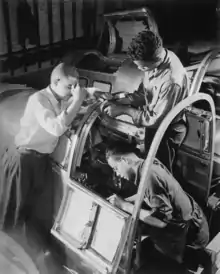
- During World War II unemployment by 1945 had fallen to 1.9% from 14.6% in 1940. 20% of the population during the war was employed within the armed forces.[34]
- The beginning years of World War II shows a spike in employment, but towards the end of the war decreased significantly. The employment spike was in relation to the tremendous amount of production the United States was making. Examples of high numbers of employment could have been seen in at Gulf Shipbuilding which obtained 240 employees at the beginning of 1940 and increased to 11,600 employees in 1943. Alabama Dry dock also was an exemplary business in employment that raised number from 1,000 workers to 30,000 in the most productive years of the war. Demographics of employment consisted of eight million women including African Americans and Latinas, adding to the 24 million that searched for defensive jobs outside of the war.[35][36]
Price of war
Many concerns and political influence come from the price of war. While GDP can easily increase Federal expenditures, it also can influence political elections and government decision making. No matter how much percentages of GDP increase or decrease we need higher amounts of GDP in order to pay for more investments, one of those investments being more wars. To pay for these wars, taxes are held at a very high rate. For example, by the end of World War II tax rates went from 1.5% to 15%. Along with tax percentages reaching high amounts, spending on non-defense programs were cut in half during the period of World War II. Tax cuts allow one to see GDP in effect for the average American. Still, almost ten years after World War II, in 1950 and 1951 congress raised taxes close to 4% in order to pay for the Korean War. After the Korean War, in 1968 taxes again were raised 10% to pay for the Vietnam War. This caused GDP to raise 1%. Although research can support positive relationship between production and jobs with GDP, research can also show the negative relationship with tax increases and GDP.[37]
US Wartime Production
Prior to the Second World War, the United States was cautious with regard to its manufacturing capabilities as the country was still recovering from the Great Depression. However, during the war, Franklin Roosevelt set ambitious production goals to fulfill. The early 1940s were set to have 60,000 aircraft increasing to 125,000 in 1943. In addition, targets for the production of 120,000 tanks and 55,000 aircraft were set during the same time period. The Ford Motor Company in Michigan built one motor car (comprising 15,000 parts) on the assembly lines every 69 seconds. Ford's production contributed to America's total production of vehicles totalling three million in 1941. American production numbers caused the US employed workforce to increase massively. America's yearly production exceeded Japan's production building more planes in 1944 than Japan built in all the war years combined. As a result, half of the world's war production came from America. The government paid for this production using techniques of selling war bonds to financial institutions, rationing household items and creating more tax revenues. Some contribution to the US wartime manufacturing boom can be ascribed to the prior creation of the Alcoa plant in the 1930s. The Alcoa plant prepared thousands of tons of aluminum used for the production of 304,000 aeroplanes during the war. The United States quickly adjusted to the levels of production required to equip its military with the millions of war products used during World War II.[38]
Personnel – Allied – Britain, dominions and possessions
Including all non-British subjects in British services.[39]
| Army | Army (female) | Navy | Navy (female) | Marines | Air Force | Air Force (female) | Auxiliary | Merchant marine | Partisans | Total combat | Other labour | |
| Aden | 1,200 | |||||||||||
| Australia | 727,703 | 24,026 | 36,976 | 3,000 | 124,007 | 27,000 | 4,500 | 942,712 | ||||
| Argentine volunteers[40] | 1,700 | 1,700 | 600 | 4,000 | ||||||||
| Basutoland/Bechuana/Swaziland | 10,000 | 36,000 | ||||||||||
| Free Belgian Forces | 42,300 | 1,200 | 1,900 | 45,770 | 370 | |||||||
| Britain | 3,300,000 | 210,309 | 865,000 | 74,000 | 78,500 | 1,208,000 | 181,909 | 1,500,000 | 185,000 | 7,602,718 | ||
| B. Indian Ocean | 6,500 | 6,500 | ||||||||||
| Canada | 705,374 | 25,251 | 99,822 | 7,100 | 222,501 | 27,123 | 82,163 | 18,000 | 1,187,334 | |||
| Caribbean / Bermuda | 10,000 | |||||||||||
| Ceylon | 26,000 | |||||||||||
| Chinese volunteers | 10,000 | 10,000 | ||||||||||
| Cyprus | 30,000 | 30,000 | ||||||||||
| Czech volunteers | 4,000 | 2,000 | 6,000 | |||||||||
| East Africa | 200,000 | 228,000 | ||||||||||
| Egypt | 100,000 | 100,000 | ||||||||||
| Falklands | 200 | |||||||||||
| Fiji | 7,000 | 1,071 | 7,000 | |||||||||
| Free French Forces | 3,700 | 20 | 3,720 | |||||||||
| Free Greek | 5,000 | 8,500 | 250 | 14,000 | ||||||||
| Gibraltar | 700 | |||||||||||
| Guiana, British | 32 | 10 | 42 | 33 | 48 | 196 | 31 | |||||
| Hong Kong | 2,200 | 2,200 | ||||||||||
| India | 2,500,000 | 11,000 | 45,947 | 30,000 | 50,000 | 2,586,957 | 14,000,000 | |||||
| Ireland | 70,000 | 70,000 | ||||||||||
| Lesoto | 21,000 | 21,000 | ||||||||||
| Free Luxembourg | 80 | 80 | ||||||||||
| Malaysia | 1,500 | 1,450 | 3,215 | 4,800 | 10,965 | |||||||
| Malta | 8,200 | |||||||||||
| Mauritius | 6,800 | 3,500 | ||||||||||
| Nepal | 250,280 | 250,280 | ||||||||||
| Free Dutch | 4,000 | 1,000 | 1000 | 12.000 | 6,000 | |||||||
| South Africa | ? | |||||||||||
Note:
- Auxiliary units include Home Guard, Reserves, Police regiments, etc.
Personnel – Axis – German Reich
This includes all German and non-German subjects serving within German Reich forces.
| Army | Army (female) | Navy | Navy (female) | Marines | Air force | Air force (female) | Auxiliary | Merchant marine | Partisans | Total combat | Other labour | |
|---|---|---|---|---|---|---|---|---|---|---|---|---|
| Albania | 9,000 | 9,000 | ||||||||||
| Arab legion | 20,000 | 20,000 | ||||||||||
| Belgium | 22,000 | 22,000 | ||||||||||
| Bulgaria | 30,000 | 90,000 | ||||||||||
| Croatia | 55,500 | 500 | 400 | 32,000 | 88,400 | |||||||
| Czech | 6,465 | 6,465 | ||||||||||
| Denmark | 12,000 | 12,000 | ||||||||||
| Finland vol | 2,500 | 2,500 | ||||||||||
| France & territories | 8,000 | 4,500 | 5,080 | 17,580 | 348,500 | |||||||
| Germany & territories | 14,793,200 | 1,500,000 | 3,400,000 | 19,693,200 | ||||||||
| Greece | 22,000 | 22,000 | ||||||||||
| Hungary | 40,000 | 40,000 | ||||||||||
| Italy | 18,000 | 18,000 | ||||||||||
| India | 4,500 | 4,500 | ||||||||||
| Luxembourg | 12,035 | 12,035 | ||||||||||
| Netherlands | 45,000 | 45,000 | ||||||||||
| Norway | 50,000 | 1,500 | 1,500 | 53,000 | ||||||||
| Poland | 75,000 | 45,000 | 120,000 | |||||||||
| Portugal | 200 | 200 | ||||||||||
| Romania | 55,000 | 55,000 | ||||||||||
| Serbia | 10,000 | 10,000 | ||||||||||
| Slovakia | 45,000 | 45,000 | ||||||||||
| Slovenia | 6,000 | 6,000 | ||||||||||
| Spain | 47,000 | 47,000 | ||||||||||
| Sweden | 300 | 300 | ||||||||||
| Switzerland | 800 | 800 | ||||||||||
| USA | 0 | 0 | ||||||||||
| USSR | 1,051,000 | 300 | 100,000 | 1,151,300 | ||||||||
| Total | 16,336,755 | 1,506,500 | 3,402,200 | 204,080 | 21,582,300 | 348,000 |
Note:
- Auxiliary units include Home Guard, Wehrmachtsgefolge, Reserves, Police regiments, etc.
- USSR includes Armenia 4k SS,14k Wehr, 7k Aux; Azerbaijan 55k SS, 70k Wehr; Belarus 12k Wehr, 20k Aux; Cossack 200k Wehr; Estonia 20k SS, 50k Wehr, 7k Aux; Georgia 10k SS; 30k Wehr; Kalmyk 5k Wehr; Latvia 55k SS; 87k Wehr, 300 Air, 23k Aux; Lithuania 50k Wehr, 10 Aux; North Caucuses 4k SS; Russia 60k SS, 26k Wehr; Turkestan 16k Wehr; Ukrainian 300k Wehr; 2k Aux; Tatar/Urals 12k Wehr
Aircraft – Allied – British Empire
Within the UK, initially aircraft production was very vulnerable to enemy bombing. To expand and diversify the production base the British set up "Shadow factories". These brought other manufacturing companies – such as vehicle manufacturers – into aircraft production, or aircraft parts production. These inexperienced companies were set up in groups under the guidance or control of the aircraft manufacturers. New factory buildings were provided with government money.[41]
Aircraft – Allies – France, Poland and minor powers
Production numbers until the time of the German occupation of the respective country. Some types listed were in production before the war, those listed were still in production at the time of or after the Munich crisis.
Aircraft - Axis - All
Occupied countries produced weapons for the Axis powers. Figures are for the period of occupation only.
Propaganda posters
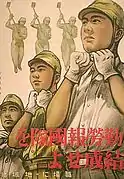 Japanese Organized Labour Service Corps poster
Japanese Organized Labour Service Corps poster USSR: "Everything for the Front. Everything for Victory"
USSR: "Everything for the Front. Everything for Victory" French-Canadian poster: "I'm making bombs and buying bonds!-Buy Victory Bonds."
French-Canadian poster: "I'm making bombs and buying bonds!-Buy Victory Bonds."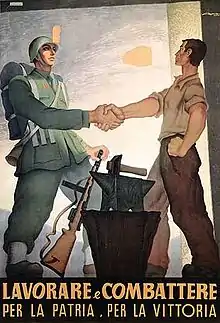 Italy: "Work and Fight for your Country and Victory"
Italy: "Work and Fight for your Country and Victory" Australia: "He's coming south—it's fight, work or perish"
Australia: "He's coming south—it's fight, work or perish"
See also
- Allied technological cooperation during World War II
- Combined Food Board
- Combined Munitions Assignments Board
- Combined Raw Materials Board
- Combined Shipping Adjustment Board
- American armored fighting vehicle production during World War II
- British armoured fighting vehicle production during World War II
- German armored fighting vehicle production during World War II
- Soviet industry in World War II
- United States aircraft production during World War II
- Forced labour under German rule during World War II
- Technology during World War II
Notes
- Naval History of WW2 Royal Navy
- Two battlecruisers of Kronshtadt-class laid down but never progressed
- wartime production only. Majority of Gladiators were built before the war. 165 additional to export customers. Sea Gladiator conversions and production in Sea Gladiator entry.
- Includes some post-war production and conversions of Spitfires
- Includes pre-war production
- includes transport and Coastal Command reconnaissance versions
- Includes 457 trainers
- most built pre-war
- Most production was pre-war
- Including: Airspeed Cambridge (2), Airspeed Fleet Shadower (1), Avro Tudor (2), Blackburn B-20 (1), Blackburn Firebrand (3) , Boulton Paul P.92 (1), Bristol Brigand (4), Burnelli CBY-3, Canada (1), CAC Woomera, Australia (2), de Havilland Dove (1), Fairey Spearfish (5), Fane F.1/40 (1), General Aircraft Cagnet (1), General Aircraft Owlet (1), General Aircraft Fleet Shadower (1), General Aircraft GAL.47 (1), General Aircraft GAL.55 (2), General Aircraft GAL.56 (4), Gloster E.28/39 (2), Gloster F.9/37 (2), Handley Page Manx (1), Hawker Tornado (4), Martin-Baker MB 3 (1), Martin-Baker MB 5 (1), Miles M.20 (2), Miles X Minor (1), Miles M.35 (1), Miles M.39 (1), Miles M.64 L.R.5 (1), Reid and Sigrist R.S.1/2 (2), Reid and Sigrist R.S.3 (1), Saro Shrimp (1), Short Shetland (2), Supermarine Type 322 (2), Vickers Type 432 (1), Vickers VC.1 Viking (1), Vickers Windsor (3)
- includes: Folland Fo.108 engine test bed (12), General Aircraft Cygnet (10), General Aircraft GAL-41 (1), Hawker Sea Fury (10), Miles Mercury (6), Percival Vega Gull (~20), Supermarine Spiteful fighter (19)
- includes: CCF Maple Leaf Trainer II (2 plus 10 built in Mexico )
- Delivered to France.
- First prototype incomplete by German occupation.
- Only 1 (designated P.11g) used by Poland in 1939. The remaining ones were exported to various Balkan countries.
- Around 200 more airframes were in advanced production stage.
- not counting uncompleted PZL.50
- Production was started in Denmark, but not completed before the German invasion.
- Originally an advanced fighter-training aircraft, this type was later used as a light attack plane, in particular by the Air Force of the Independent State of Croatia.
- not counting P.4/34
- According to some sources license production started in Denmark but not completed before the German invasion.
- All but 5 delivered to Bulgaria.
- Prototypes that were used in combat.
- Never entered service
- Number refers to production resumed after German occupation.
- Produced shortly before the war and mainly used for testing and propaganda purposes.
- Conversion from MS.406/410.
- Conversion from MS.406.
- Produced before the war and 2 used by Japanese for testing.
- All produced before the war, but used until 1944.
- Only 90 German-built Me 210 were completed and delivered, about 100 Hungarian-built were supplied to Germany
- Also used as a fighter and for reconnaissance
- Produced for Germany after German occupation.
- Only bomber versions listed here.
Citations
- Herman, Arthur. Freedom's Forge: How American Business Produced Victory in World War II, p. IX, Random House, New York, NY, 2012. ISBN 978-1-4000-6964-4.
- Parker, Dana T. Building Victory: Aircraft Manufacturing in the Los Angeles Area in World War II, p. 7, Cypress, CA, 2013. ISBN 978-0-9897906-0-4.
- Wrynn, V. Dennis. Forge of Freedom: American Aircraft Production in World War II, pp. 4-5, Motorbooks International, Osceola, WI, 1995. ISBN 0-7603-0143-3.
- Baldwin, Ralph B. The Deadly Fuze: Secret Weapon of World War II, pp. 4-6, 11, 50, 279, Presidio Press, San Rafael, California, 1980. ISBN 978-0-89141-087-4.
- Kumanev, G.A., "War and the evacuation of the USSR: 1941-1942", New Age, 2006
- Sawyer, L. A. and Mitchell, W. H. The Liberty Ships: The History of the "Emergency" Type Cargo Ships Constructed in the United States During the Second World War, Second Edition, pp. vii, 1-8, Lloyd's of London Press Ltd., London, England, 1985. ISBN 1-85044-049-2.
- Parker, Dana T. Building Victory: Aircraft Manufacturing in the Los Angeles Area in World War II, pp. 5, 7, Cypress, CA, 2013. ISBN 978-0-9897906-0-4.
- Parker, Dana T. Building Victory: Aircraft Manufacturing in the Los Angeles Area in World War II, p. 8, Cypress, California, 2013. ISBN 978-0-9897906-0-4.
- "Financial Calculators". dollartimes.com.
- Office of Statistical Control. Army Air Force Statistical Digest, World War II. p. 127.
- Office of Statistical Control. Army Air Force Statistical Digest. p. 16.
- "Expanding the Size of the U.S. Military in World War II". warfarehistorynetwork.com. 26 June 2017. Archived from the original on 12 August 2018. Retrieved 13 March 2019.
- "Why Japan Really Lost The War". Combined Fleet. Retrieved 2018-06-18.
- "Why Japan Really Lost The War". Combined Fleet. Retrieved 2018-06-18.
- Mitchell, B.R. British Historical Statistics, 1988
- http://www.teindia.nic.in/mhrd/50yrsedu/15/8P/82/8P820T03.htm
- Dialogue on Aluminium 110 years of history in Canada approximation
- Baker The New Zealand People at War: War Economy 1965
- Lend Lease as a Function of the Soviet war Economy
- Accounting for War: Soviet Production, Employment and the Defense Burden, 1940-1945 Mark Harrison, 1996
- Including 23.4 synthetic.
- Volume 3 -The Effects of Strategic Bombing on the German War Economy 1940-1944 only, retrieved June 8, 2014
- "Comparison of GDP adjusted for actual yearly shared contribution to war efforts after Zuljan, Ralph, Allied and Axis GDP", Articles On War, OnWar.com, 2003, archived from the original on August 6, 2014, retrieved June 8, 2014
- Harrison, 1998
- Stephen Broadberry, Kevin H. O'Rourke, The Cambridge Economic History of Modern Europe: Volume 2, 1870 to the Present, p. 190
- ROMANIA: historical demographical data of the whole country
- HUNGARY: historical demographical data of the whole country
- BULGARIA historical demographical data of the whole country
- ALBANIA: historical demographical data of the whole country
- General Article: Foreign Affairs, pbs.org
- "The Economic Consequences of War on US Economy" (PDF). Institute for Economics and Peace. June 2015. Retrieved 6 October 2017.
- "Defence Spending since 1900". UK Public Spending. Retrieved 2018-06-18 – via Christopher Chantrill.
- "The Economic Consequences of War on US Economy" (PDF). Institute of Economics and Peace. June 2015. Retrieved 6 October 2017.
- "THE WAR: At Home – War Production". The War At Home Production. PBS. Retrieved 2017-04-12.
- "Graph of U.S. Unemployment Rate, 1930-1945". Bureau Of Labor Statistics. HERB: Resources for Teachers. Retrieved 30 November 2017.
- Bartlett, Bruce. "The Cost Of War". Forbes.com. Forbes. Retrieved 2017-10-26.
- "THE WAR: At Home – War Production". pbs.org. PBS. Retrieved 2017-04-12.
- Rose, Patrick (2012). The Indian Army, 1939–47: Experience and Development. Routledge.
-
- The Anglo-Argentine Society in conjunction with the Argentine Embassy (6 April 2005). "Wings of Thunder – Wartime RAF Veterans Flying in From Argentina" (Press release). London: PRNewswire.
- Granatstein, Dr. J. L. (May 27, 2005). "ARMING THE NATION: CANADA'S INDUSTRIAL WAR EFFORT, 1939-1945" (PDF). Canadian Council of Chief Executives. Retrieved April 5, 2016.
- Ethell, Jeffrey L. and Steve Pace. Spitfire. St. Paul, Minnesota: Motorbooks International, 1997. ISBN 0-7603-0300-2. p117
- 3 prototypes and 3 delivered to RAF
- Canso production
Personnel -Allied - British Empire
- Australia 2
- "Facts & Information" Canada at War July 4, 2009
- Colonel C.P. Stacey. "Chapter XIX Conclusion". Repatriation and Demoblization. The Canadian Army 1939-1945: An Official Historical Summary – via hyperwar.
- Daniel Owen Spence, Imperial Loyalties, 'Imagined Communities' and 'Britishness': The Royal Navy and the Cayman Islands
- Sherwood, Marika (30 March 2011), Colonies, Colonials and World War Two, BBC History
- Gillespie, Oliver A. "I: New Zealand's Responsibility" The Pacific Historical Publications Branch, 1952, Wellington (The Official History of New Zealand in the Second World War 1939–1945)
- India
- "Officers Database FAQ" bharat-rakshak.com
- India 3 idsa.in
- India Pioneers defencejournal.com
- India RIAF BBC WWII Peoples War
- Brigade Peron Luxembourg Army
- Malay
- Merchant Navy
- Netherlands
- Netherlands
- Newfoundland
- New Zealand
- Nigeria
- Saunders, Hilary St. George (1954), "Volume III The Fight Is Won", Royal Air Force 1939-1945, London: HMSO
- South Africa
- South Africa
- South Africa Navy History
- Martin Plaut (11 March 2014), African troops who fought in World War Two, Martin Plaut
- West Africa
- West Africa country-data.com
- "Fact File : Commonwealth and Allied Forces", WWII Peoples War, BBC
Personnel - Axis
- Croatia 2, Munoz 1996
- Croatia 3, Tomasevich 2001
- Czech
- Poland 2
- The Latvian Squadrons in the Luftwaffe, Latvianaviation.com
- Volunteers, Ailsby 2004
Aircraft - Allied
- Australia
- Bristol Brigand
- Free Dutch
- New Zealand
- Barnes 1989
- Bishop 2002
- Bowyer 1980
- Butler 2004
- Flint 2006
- Green 1967
- Jackson 1987
- Jane's 1989
- Mason 1994
- Morgan ?
- Otway 1990
- Swanborough 1997
- Tapper 1988
- The Illustrated Encyclopedia of Aircraft, 1985
Aircraft - Axis
- Comando Supremo: Italy at War
- Dressel and Griehl 1994
- Encyclopedia of weapons of World War Two
- Francillon 1970
- The Illustrated Encyclopedia of Aircraft, 1985
- Jane's 1989
- Mondey 1996
- Smith and Anthony ?
Raw materials
- The Mineral Industry of the British Empire and Foreign Countries, Statistical Summary 1938–1944, The Imperial Institute, HMSO, 1948
- The Mineral Industry of the British Empire and Foreign Countries, Statistical Summary 1941–1947, The Imperial Institute, HMSO, 1949
Official histories
- History of the Second World War (104 volumes), Her Majesty's Stationery Office, London 1949 to 1993
- Official History of Australia in the War of 1939–1945 (22 volumes), Australian Government Printing Service, 1952 to 1977
- Official History of the Canadian Army in the Second World War, Vol I Six Years of War, Stacey, C P., Queen's Printer, Ottawa, 1955
- Official History of the Indian Armed Forces in the Second World War 1939-45 (24 volumes), Combined Inter-Services Historical Section, India & Pakistan, New Delhi, 1956-1966
- Official History of New Zealand in the Second World War 1939–45, Historical Publications Branch, Wellington, New Zealand, 1965
Bibliography
- Ailsby, Christopher, Hitler's Renegades: Foreign Nationals in the Service of the Third Reich (Photographic Histories), Potomac Books, 2004
- Barnett, Correlli, The audit of war : the illusion & reality of Britain as a great nation, Macmillan, 1986
- Barnes, C.H.; James D.N. Shorts Aircraft since 1900, London, Putnam, 1989
- Bishop, Chris, The Encyclopaedia of Weapons of World War II, Sterling Publishing, 2002
- Bowyer, Michael J.F. Aircraft for the Royal Air Force: The "Griffon" Spitfire, The Albemarle Bomber and the Shetland Flying-Boat, London, Faber & Faber, 1980
- Boyd, David, (2009) "Wartime Production by the Commonwealth during WWII" British Equipment of the Second World War
- Boyd, David (2009), "British Production of Aircraft By Year During The Second World War", British Equipment of the Second World War
- Butler, Tony. British Secret Projects: Fighters and Bombers 1935–1950. Hinckley, UK: Midland Publishing, 2004
- Canada at War, "The Canadian War Industry"
- Dressel, Joachim and Manfred Griehl. Bombers of the Luftwaffe. London: DAG Publications, 1994
- Flint, Keith, Airborne Armour: Tetrarch, Locust, Hamilcar and the 6th Airborne Armoured Reconnaissance Regiment 1938-1950. Helion & Company Ltd., 2006
- Francillon, René J., Japanese Aircraft of the Pacific War, London, Putnam, 1970
- Gregg, W.A ed., Canada’s Fighting Vehicles Europe 1943-1945, Canadian Military Historical Society, 1980
- Green, William. War Planes of The Second World War:Volume Seven - Bombers and Reconnaissance Aircraft. London: Macdonald, 1967
- Harrison, Mark, "The Economics of World War II: Six Great Powers in International Comparison", Cambridge University Press, 1998 (Author's overview)
- Herman, Arthur. Freedom's Forge: How American Business Produced Victory in World War II, Random House, New York, 2012
- The Illustrated Encyclopedia of Aircraft (Part Work 1982-1985). London: Orbis Publishing, 1985
- Jackson, A.J., De Havilland Aircraft since 1909 (Third ed.), London, Putnam, 1987
- Jane's Fighting Aircraft of World War II, London, Studio Editions Ltd, 1989
- "Les luxembourgeois de la Brigade Piron". (in French) Armee.lu. Retrieved 29 June 2013
- Long, Jason, Lend Lease as a Function of the Soviet war Economy, sturmvogel.orbat.com, Retrieved June 12, 2014
- Mason, Francis K. The British Bomber since 1914, London: Putnam Aeronautical Books, 1994
- Milward, Alan S., War, economy, and society, 1939-1945, University of California Press, 1979
- Morgan, Eric B. "Albemarle" in Twentyfirst Profile, Volume 1, No. 11. New Milton, Hants, UK: 21st Profile Ltd.
- Munoz, A.J., For Croatia and Christ: The Croatian Army in World War II 1941–1945, Axis Europa Books, NY, 1996
- Mondey, David. The Concise Guide to Axis Aircraft of World War II. New York: Bounty Books, 1996
- Ness, Leland, Jane's World War II Tanks and Fighting Vehicles, The Complete Guide, Harper Collins, 2002
- Otway, Lieutenant-Colonel T.B.H. The Second World War 1939-1945 Army: Airborne Forces. London: Imperial War Museum, 1990
- Overy, Richard, Why the Allies Won (Paperback), W. W. Norton & Company, 1997
- Scientia Militaria, South African Journal of Military Studies
- Smith, J.R. and Anthony L. Kay. German Aircraft of the Second World War. London: Putnam and Company Ltd.,
- Swanborough, Gordon. British Aircraft at War, 1939-1945. East Sussex, UK: HPC Publishing, 1997
- Tapper, Oliver. Armstrong Whitworth Aircraft since 1913. London: Putnam, 1988
- Tomasevich, Jozo, War and Revolution in Yugoslavia, 1941–1945: Occupation and Collaboration 2. San Francisco: Stanford University Press, 2001
- Veterans Affairs Canada, "Canadian Production of War Materials"
- Wilson, Stewart, Aircraft of WWII, 1998
- Wrynn, V. Dennis. Forge of Freedom: American Aircraft Production in World War II, Motorbooks International, Osceola, WI, 1995
- Zuljan, Ralph, "Allied and Axis GDP" Articles On War OnWar.com (2003)
External links
| Wikimedia Commons has media related to Military industrial production during World War II. |
- Allies and Lend-Lease Museum, Russia
- Australia War Memorial official war history online archive
- Canada at War
- National War Museum, United States
- New Zealand in the Second World War, official war history online
- South Africa Journal of Military Studies
